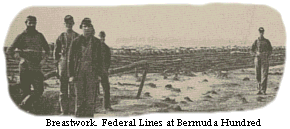 In its widest non-technical sense the term breastwork
was commonly used to refer to any protective embankment arranged for a musket
armament that provided cover to the level of the chest. This could include
field works with ditch and parapet profiles, trench and embankment profiles,
or simple epaulments temporarily used as cover for infantry. In a more technical
sense a breastwork was any parapet that did not include a raised banquette
tread or banquette slope in its profile. In its widest non-technical sense the term breastwork
was commonly used to refer to any protective embankment arranged for a musket
armament that provided cover to the level of the chest. This could include
field works with ditch and parapet profiles, trench and embankment profiles,
or simple epaulments temporarily used as cover for infantry. In a more technical
sense a breastwork was any parapet that did not include a raised banquette
tread or banquette slope in its profile.
Since the interior crests of breastworks' parapets were only 4
to 5 feet above the natural level of the ground they could be raised more
rapidly than a full parapet, but when sited on level ground their low profiles
did not adequately defilade the interior side of the fortification from enemy
fire. Breastworks were particularly useful on wet ground with a high water
table that disallowed the excavation of a deep ditch or trench; soil for
the
 breastwork could be taken from shallow trenches both in front
and to the rear of the parapet. This advantage also applied to ground where
a thin layer of topsoil covered a solid rock bed. Breastworks were also useful
when positioned along the crests of ridge lines where the attacking troops
approaching the work or standing near the foot of the exterior slope could
not see over the parapet. breastwork could be taken from shallow trenches both in front
and to the rear of the parapet. This advantage also applied to ground where
a thin layer of topsoil covered a solid rock bed. Breastworks were also useful
when positioned along the crests of ridge lines where the attacking troops
approaching the work or standing near the foot of the exterior slope could
not see over the parapet. |